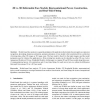Free Online Productivity Tools
i2Speak
i2Symbol
i2OCR
iTex2Img
iWeb2Print
iWeb2Shot
i2Type
iPdf2Split
iPdf2Merge
i2Bopomofo
i2Arabic
i2Style
i2Image
i2PDF
iLatex2Rtf
Sci2ools
IJCV
2007
2007
2D vs. 3D Deformable Face Models: Representational Power, Construction, and Real-Time Fitting
Model-based face analysis is a general paradigm with applications that include face recognition, expression recognition, lip-reading, head pose estimation, and gaze estimation. A face model is first constructed from a collection of training data, either 2D images or 3D range scans. The face model is then fit to the input image(s) and the model parameters used in whatever the application is. Most existing face models can be classified as either 2D (e.g. Active Appearance Models) or 3D (e.g. Morphable Models). In this paper we compare 2D and 3D face models along three axes: (1) representational power, (2) construction, and (3) real-time fitting. For each axis in turn, we outline the differences that result from using a 2D or a 3D face model.
| Added | 15 Dec 2010 |
| Updated | 15 Dec 2010 |
| Type | Journal |
| Year | 2007 |
| Where | IJCV |
| Authors | Iain Matthews, Jing Xiao, Simon Baker |
Comments (0)

